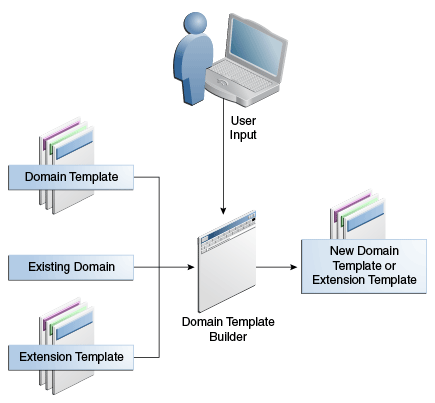1 Introduction
This chapter includes the following sections:
1.1 Overview of the Domain Template Builder
You can create WebLogic domains by using domain and extension templates that contain the key attributes and files required for building or extending a WebLogic domain. To create domain or extension templates, you use the Domain Template Builder, which is a standalone Java application that guides you through the process. This process is illustrated in Figure 1-1.
The Domain Template Builder is designed to be used off-line in graphical mode. It is not supported in console mode. Therefore, the console attached to the machine on which you are using the Domain Template Builder must support Java-based GUIs. All consoles for Windows systems support Java-based GUIs; some UNIX-based consoles support Java-based GUIs.
Your product installation includes a set of predefined domain and extension templates. This set of templates includes the WebLogic Server Base Domain template, and various extension templates that allow you to add product features and samples to the base domain. For more information on the templates that are available for various products, see the Domain Template Reference.
After you create your domain and add new resources and applications to it, you can use the Domain Template Builder to create a domain and extension templates. To do so, select the existing domain or template as the source for your new domain or extension templates. When your custom domain templates are complete, you can use them to create domains by using the Configuration Wizard, WLST Offline, or the unpack command. For more information about these tools, see Additional Tools for Creating Templates.
1.2 About Domain and Extension Templates
In the context of the Domain Template Builder, the term template refers to a Java Archive (JAR) file. A template JAR contains the files and scripts that are needed to create or extend a WebLogic domain. The types of templates that can be used by the Configuration Wizard to create or extend domains include:
-
Domain template—defines the full set of resources within a WebLogic domain, including infrastructure components, applications, services, security options, and general environment and operating system options. You can create this type of template from an existing domain by using the Domain Template Builder or the
packcommand. You can then create a domain based on the template.The product distribution includes the WebLogic Server Base Domain template. This template defines the core set of resources within a domain, including an Administration Server and basic configuration information, infrastructure components, and general environment and operating system options. It does not include sample applications. You can use this template to create a basic WebLogic Server domain, which you can then extend with applications and services, or additional product component functionality.
-
Extension template—defines applications and services that can provide additional features, such as applications, or JDBC resources, JMS components, or deployed libraries. This type of template can be used to update an existing WebLogic domain.
-
Managed Server template—defines the subset (within a domain) of resources that are required to create a Managed Server domain on a remote machine. This type of template can be created using the
packcommand.
Your product installation includes a set of predefined domain and extension templates. This set includes the WebLogic Server Base Domain template and various extension templates that allow you to add component features and samples to the base domain. For more information about these templates and how they relate to each other, see the Domain Template Reference.
1.3 Additional Tools for Creating Templates
As described earlier, you can create custom domain and extension templates by using the Domain Template Builder. You can also use the following tools to create templates:
-
packThis command enables you to create a template archive (JAR file) that contains a snapshot of either an entire WebLogic domain or a subset of a WebLogic domain. You can use a template that contains a subset of a domain to create a Managed Server domain directory hierarchy on a remote machine.
For more information, see Creating Templates and Domains Using the Pack and Unpack Commands.
-
WebLogic Scripting Tool (WLST):
WLST is a command-line scripting interface, which you can use to interact with and configure WebLogic Server instances and domains. When WLST is offline, you can create a WebLogic domain or update an existing WebLogic domain without connecting to a running WebLogic Server—supporting the same functionality as the Configuration Wizard.
For more information, see Understanding the WebLogic Scripting Tool and WLST Command Reference for WebLogic Server.
